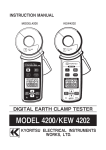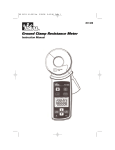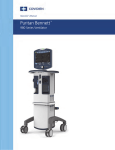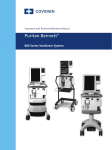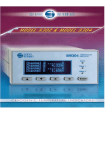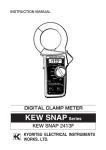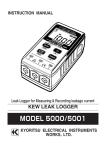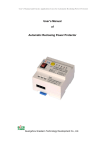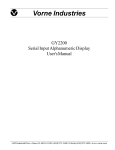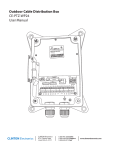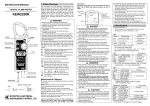Download Instruction Manual
Transcript
INSTRUCTION MANUAL
DIGITAL EARTH CLAMP TESTER
MODEL 4200
KYORITSU ELECTRICAL INSTRUMENTS
WORKS,LTD.
Contents
1. Safety warnings ..................................................................................... 1
2. Features ................................................................................................ 3
3. Specification .......................................................................................... 4
4. Instrument layout ................................................................................... 6
5. Measurement principle .......................................................................... 7
6. Preparation for measurement ................................................................ 9
7. Measuring method ............................................................................... 10
7-1 Normal measurement of current ...................................................... 11
7-2 Measurement of Balance leakage current ...................................... 11
7-3 Measurement of earth resistance ................................................... 12
8. Other functions .................................................................................... 14
8-1 Auto power-off function .................................................................. 14
8-2 Data hold function............................................................................ 14
8-3 Buzzer function ................................................................................ 14
8-4 Backlight function ............................................................................ 14
8-5 Memory function .............................................................................. 15
9. Battery replacement ............................................................................ 16
10. Service ................................................................................................ 17
1. Safety Warnings
This instrument has been designed, manufactured and tested according to IEC
61010: Safety requirements for Electronic Measuring apparatus, and delivered in
the best condition after passed the inspection. This instruction manual contains
warnings and safety procedures which have to be observed to ensure safe
operation of the instrument and maintain it in a safe condition.
Thus, these operating instructions have to be read prior to using the instrument.
WARNING
¡ Read through and understand the instructions contained in this manual
before using the instrument.
¡ Keep the manual at hand to enable quick reference whenever necessary.
¡ Be sure to use the instrument only in its intended applications.
¡ The instrument is to be used only in its intended applications.
¡ Understand and follow all the safety instructions contained in the manual.
It is essential that the above instructions are adhered to. Failure to follow the
above instructions may cause injury, instrument damage and/or damage to
equipment under test.
○ The symbol
indicated on the instrument means that the user must refer
to the related parts in the manual for safe operation of the instrument. It is
essential to read the instructions wherever the
symbol appears in the
manual.
DANGER : is reserved for conditions and actions that are likely to cause
serious or fatal injury.
WARNING : is reserved for conditions and actions that can cause serious or
fatal injury.
CAUTION : is reserved for conditions and actions that can cause injury or
instrument damage.
○ Following symbols are used on the instrument. Attention should be paid to each
symbol to ensure your safety.
This symbol indicates that the user must refer to the explanations in the
instruction manual.
symbol indicates that the instrument is protected by double or reinforced
FThis
insulation.
This symbol indicates that this instrument can clamp on bare conductors.
∼This symbol indicates AC.
―1―
DANGER
¡ Never make measurement on a circuit in which the electrical potential exceeds
AC300V.
¡ Do not make measurement when thunder is rumbling. Stop measurement and
take off the instrument from the object under test.
¡ Do not attempt to make measurement in the presence of flammable gasses.
Otherwise, the use of the instrument may cause sparking, which can lead to an
explosion.
¡ To avoid electrical shock by touching the equipment under test or its
surroundings, be sure to wear insulated protective gear.
¡ Transformer jaws are made of metal and their tips are not completely insulated.
Be especially careful about the possible shorting where the equipment under test
has exposed metal parts.
¡ Never attempt to use the instrument if its surface or your hand are wet.
¡ Do not exceed the maximum allowable input of any measuring range.
¡ Do not measure a current over 30A. Transformer jaws may heat to cause a fire
or deformation of molding parts, which will degrade insulation. When clamping
the conductors on which over 30A flowing and "
" is displayed on the LCD,
stop measurement immediately and take off the instrument from the conductor
under test.
¡ Never open the Battery cover during a measurement.
¡ When the transformer jaws are worn to the wear line (see the figure below), stop
the use of the instrument.
WARNING
¡ Never attempt to make any measurement if any abnormal conditions, such as a
broken cover or exposed metal parts are present on the instrument.
¡ Do not install substitute parts or make any modification to the instrument. Return
the instrument to your local distributor from who you purchased this instrument
for repair or re-calibration.
¡ Do not try to replace the batteries if the surface of the instrument is wet.
¡ Always turn off the instrument before opening the Battery cover for battery
replacement.
¡ Always be sure to keep your fingers and hands behind the Safety barrier.
(see the figure below) Otherwise, user may be exposed to the danger of
electrical shock.
CAUTION
¡ Press the Function button and confirm the appropriate function is selected before
starting a measurement.
¡ Do not expose the instrument to the direct sun, high temperatures and humidity
or dew.
¡ Press the Power button and turn off the instrument after use. When the
instrument will not be in use for a long period, place it in storage after removing
the batteries.
¡ Use a cloth dipped in water or neutral detergent for cleaning the instrument. Do
not use abrasives or solvents.
¡ Take sufficient care not to apply shock such as drop. Otherwise, precisely
adjusted Transformer jaws will be damaged.
¡ Be careful not to pinch some foreign substances with the Transformer jaw tips.
―2―
2. Features
This instrument is a digital clamp-on earth resistance tester, and it is used in multiearthed systems. Can measure the earth resistance by simply clamping around
the earthed wires.
This instrument also equips AC current function to measure current up to 30A
same to our traditional leakage clamp meters.
¡ Wide measuring range (Auto-ranging)
Earth resistance
Max. 1200Ω
AC current
Max. 30A
Min. resolution 0.01Ω
Min. resolution 0.1mA
¡ Noise check function
A function to detect current, which effects on an earth resistance measurement
and display the NOISE mark on the LCD.
¡ True RMS
Accurate true RMS readings of AC current with distorted waveform.
¡ Auto power-off function
A function to prevent the instrument from being left turned on and conserve
battery power.
¡ Data hold function
A function to freeze the measured value on the display.
¡ Buzzer function
A function to give audible warning to the user when the measurement result is
10Ω or less.
¡ Backlight function
A function to facilitate working at dimly lit areas.
¡ Memory function
A function to save and display the measurement result.
¡ Designed to following safety standard.
IEC61010-1: 2001 (CAT.IV 300V Pollution degree 2), IEC61010-2-032: 2002
¡ This instrument is protected by double or reinforced insulation F.
―3―
3. Specification
¡Measuring range and accuracy
Range
Function
20Ω
Earth resistance
200Ω
Resolution
0.01Ω
0.1Ω
(Auto-ranging)
1200Ω
AC current (ACA)
(sine wave)
(50Hz/60Hz)
(Auto-ranging)
100mA
1000mA
10A
30A
1Ω
10Ω
0.1mA
1mA
0.01A
0.1A
Measuring range
Accuracy
0.00 ∼ 20.99Ω ±1.5%±0.05Ω
16.0∼99.9Ω
±2%±0.5Ω
100.0∼209.9Ω ±3%±2Ω
±5%±5Ω
160 ∼ 399Ω
400 ∼ 599Ω ±10%±10Ω
600 ∼ 1260Ω
−
0.0∼104.9mA ±2%±0.7mA
80∼1049mA
±2%
0.80∼10.49A
8.0∼31.5A
* Crest factor ≦2.5 Accuracy at sine wave +1% (50Hz/60Hz, peak value shall not exceed 60A)
* In the following cases, zero will be displayed on the LCD.
At 20Ω range of Earth resistance function: 0.04Ω or less
* A range shifts to upper range when the input exceeds 105% of the selected range, and shifts
to the lower range when the input falls under 80% of the lower range.
¡ Operating system
¡ Display
¡ Over-range indication
¡ Response time
Earth resistance function: Constant voltage injection,
Current detection,
(Frequency: Approx.2400Hz)
Dual Integration
AC current function:Successive Approximation(True-RMS)
Liquid crystal display with a maximum count of 2099
"OL" is displayed when input exceeds the upper limit
of a measuring range
Earth resistance function:Approx. 7 seconds
AC current function
:Approx. 2 seconds
Approx. once per second
Altitude 2000m or less, In door/ out door use
IP40
23℃±5℃/Relative humidity 85% or less
(no condensation)
¡ Sample rate
¡ Location for use
¡ IP protection degree
¡ Temperature &
humidity range
(guaranteed accuracy)
¡ Operating temperature & -10℃∼40℃/Relative humidity 85% or less
humidity range
(no condensation)
¡ Storage temperature & -20℃∼60℃/Relative humidity 85% or less
humidity range
(without batteries, no condensation)
¡ Power source
DC6V: R6P (size AA manganese battery) x 4pcs, or
LR6 (size AA alkaline battery) x 4pcs
¡ Current consumption
Approx. 50mA (max. 100mA)
¡ Measurement time
Approx. 12 hours (when R6P is used),
Approx. 24 hours (when LR6 is used)
¡ Auto power-off
Turns power off about 10 minutes after the last
button operation.
―4―
¡ Applicable standards
¡ Electrostatic discharge
immunity
¡ Withstand voltage
¡ Insulation resistance
¡ Conductor size
¡ Dimension
¡ Weight
¡ Accessories
IEC61010-1: 2001 (CAT. IV 300V Pollution degree2)
IEC61010-2-032: 2002
IEC61326: 2000 (EMC standard)
Performance criteria B
AC5320Vrms/ 5 seconds
Between the Transformer jaws fitted parts and Case
enclosure (except for jaws)
50MΩ or more at 1000V
Between the Transformer jaws fitted parts and Case
enclosure (except for jaws)
Approx. 32mm in diameter max.
246(L) x 120(W) x 54(D)mm
Approx. 780g (including batteries)
Battery R6P
: 4pcs
Instruction manual
: 1pce
Resistor for operation check : 1pce
(MODEL8304)
Hard case MODEL9128
: 1pce
<Supplemental remarks>
○ Effective value (RMS)
Most alternating currents and voltages are expressed in effective values, which are also
referred to as RMS (Root-Mean-Square) values. The effective value is the square root of the
average of square of alternating current or voltage values. Many clamp meters using a
conventional rectifying circuit have "RMS" scales for AC measurement. The scales are,
however, actually calibrated in terms of the effective value of a sine wave though the clamp
meter is responding to the average value. The calibration is done with a conversion factor of
1.111 for sine wave, which is found by dividing the effective value by the average value.
These instruments are therefore in error if the input voltage or current has some other shape
than sine wave.
○ CF (Crest Factor) is found by dividing the peak value by the effective value.
Examples:
Sine wave: CF=1.414 Square wave with a 1: 9 duty ratio: CF=3
―5―
4. Instrument layout
¡ Name of each parts and buttons
1 Transformer jaw
2 Trigger
3 Backlight button
Switches on/off the backlight.
4 Function button
Switches ACA/ Earth resistance
function.
5 Memory mode button
Check the measured value with
each data number.
6 Data hold button
Holds the indicated value.
Release the held value.
7 Power button
Turns on/off the instrument.
8 Display unit (LCD)
9 Cursor button (UP)
Selects data number; to save the
measured value, or to view the
measured data in memory.
10 Cursor button (DOWN)
Selects data number; to save the
measured value, or to view the
measured data in memory.
11 Save button
Saves the measured value.
1
2
3
6
4
7
8
9
11
5
10
¡ Marks to be displayed on the LCD
Displayed when saving the measured value or when
instrument is in memory mode.
Data number
1 to 100
Displayed when batteries are exhausted.
Displayed at Earth resistance function when
Transformer jaws are not properly closed.
Displayed at Earth resistance function when current or
noise, which effect on the measured value, presents.
Displayed when data hold function is activated.
Displayed when ACA function is selected.
Displayed when instrument is in continuity mode at
Earth resistance function.
―6―
Measured value
Unit
5. Measurement principle
This instrument can measure the earth resistance to earth in multi-earthed
system.
Let's regard earth resistance under test as Rx, and the other earth resistances as
R1, R2, …Rn.
Rx
R1
R2
Rn
Of these earth resistances, R 1 , R 2 , …Rn can be considered that they are
connected in parallel.
And can be regarded as a combined resistance Rs. The Rs can be regarded small
enough against Rx since a combined resistance consists of several resistances.
Following is an equivalent circuit diagram of this circuit.
Rx
R1
R2
Rn
Rx
Rs =
1
∑ Ri1
n
i =1
―7―
Rs
By applying the Voltage (V) to the circuit from the Transformer jaw (CT1), current I
is (shall be flowed) flowed corresponding to the earth resistance. R can be put out
by the calculation after detecting the current with the other Transformer jaw (CT2).
In this case, R displayed in this instrument can be regarded as Rx because Rs
can be regarded small enough against Rx.
I
V
I
= R = Rx + Rs
CT1
Rx〉〉Rs =
∑ Ri1
n
V
1
CT2
i =1
V
I
= Rx
Rx
Rs
CAUTION
This instrument cannot support the measurement for the locations with
following earth systems.
¡ Single-earth that is not connected to other earths. (Lightning rod, etc.)
¡ Earth on which a current over 2A is measured at AC current function of this
instrument.
¡ Earth with a larger earth resistance than an earth resistance of testing.
¡ Earth with earth resistance over 1200Ω.
Precision measurement shall be performed with our Earth resistance tester:
M4102A or M4105A for the measurement of single-earthed wire.
Measurement example using M4102A
Earthed electrode
under test
―8―
Auxiliary earth spikes
6. Preparation for measurement
CAUTION
This instrument performs self-calibration for about 3 seconds when it is turned
on. ("
" is displayed on the LCD.) Do not clamp on to any conductor or
open the jaws in this period. Otherwise, inaccurate measurement may occur.
(1) Check the battery voltage
When nothing is displayed on the LCD, press the power button
and turn
on the instrument. Battery voltage is enough when indication is clear and the
"
" mark is not displayed on the LCD after turning on the instrument.
Follow the procedure described in “9. Battery replacement” and replace
the batteries with new one when any of following symptoms is noted.
Otherwise, accurate measurement and proper saving cannot be ensured.
*"
" mark is being displayed.
* indications are faint and difficult to read.
* nothing is displayed on the LCD.
(2) Verify the correct measurement of earth resistance
Clamp-on the supplied resistor for operation check (MODEL8304) as shown
below, and verify that the Transformer jaw and the circuit works correctly.
When the indicated value is within the range described below, they are
operating correctly. If the indicated value is greatly exceeding the accuracy,
send the instrument for repair according to "10. Service".
For repair, the resistor for operation check (MODEL8304) shall be attached
and returned together with the instrument.
Resistor for operation check
1Ω
1Ω
Ω
01
1Ω loop
10Ω loop
Resistor for operation check
Allowable range
1Ω
0.93 ∼ 1.07
10Ω
9.75 ∼ 10.25
―9―
Ω
01
7. Measuring method
DANGER
¡ Never make measurement on a circuit in which the electrical potential
exceeds AC300V.
¡ Transformer jaws are made of metal and their tips are not completely
insulated. Be especially careful about the possible shorting where the
equipment under test has exposed metal parts.
¡ Never make measurement with the Battery cover removed.
¡ Do not measure a current over 30A. Transformer jaws may heat to cause a
fire or deformation of molding parts, which will degrade insulation. When
clamping the conductors on which over 30A flowing and "
" is displayed
on the LCD, stop measurement immediately and take off the instrument
from the conductor under test.
CAUTION
¡ Take sufficient care not to apply shock, vibration or excessive force to the
jaw tips.
Otherwise, precisely adjusted Transformer jaws will be damaged.
¡ This instrument performs self-calibration for about 3 seconds when it is
turned on. ("
" is displayed on the LCD.) Do not clamp on to any
conductor or open the jaws in this period. Otherwise, inaccurate
measurement may occur.
¡ When foreign substances are stuck in the jaw tips or they cannot properly
engage, the Transformer jaws do not fully close. In such a case, do not
release the jaw trigger abruptly or attempt to close the Transformer jaws by
applying external force. Make sure that the jaws close by themselves after
removing the foreign substance or making them free to move.
¡ The size of a conductor can be tested is 30mm in diameter. Accurate
measurement cannot be made on a conductor larger than this, because the
Transformer jaws cannot fully close.
Never attempt to apply excessive force to close the jaws.
¡ When measuring large current, the Transformer jaws may buzz. This has
no effect on the instrument's performance or safety.
¡ Sensitive Transformer jaws are used for this instrument. Because of the
characteristics of Transformer jaws, which can be opened and closed, it is
impossible to eliminate the interference of external magnetic field
completely. If there are something, which generating large magnetic field, at
a nearby site, current value can be displayed. ("0" cannot be displayed.)
Before clamping on the conductor. For such a case, please use the
instrument at a location far from the thing, which generating magnetic field.
Following are the typical things generating magnetic field.
* Conductor fed large current
* Motor
* Equipment which has magnet
* Integrating wattmeter
― 10 ―
7-1 Normal measurement of current
* Press the Function button
and select the ACA function.
* Confirm the displayed unit is " mA ", and the " MEM " mark is not displayed at
the upper left on the LCD.
* Press the trigger to open the Transformer jaws, and close them over one
conductor only.
* Measured current value is displayed on the LCD.
(Earth leakage current that flows through an earthed wire can be measured by
this method.)
L
o
a
d
7-2 Measurement of Balance leakage current
* Press the Function button
and select the ACA function.
* Confirm the displayed unit is " mA ", and the " MEM " mark is not displayed at
the upper left on the LCD.
* Clamp onto all conductors except an earthed wire.
* Measured current value is displayed on the LCD.
Load
Load
Single-phase 2-wire system
Three-phase 3-wire system
In 3-wire system with neutral,
clamp onto all 3 wires.
In 4-wire system with neutral,
clamp onto all 4 wires.
― 11 ―
7-3 Measurement of earth resistance
CAUTION
¡ Follow the procedure described in "7-1 Normal measurement of current"
and measure the current flowing on the earthed wire prior to the
measurement of earth resistance.
In case that the "
" mark is displayed at the upper right of the LCD, it
means that a great error would be included in the measured result. To avoid
such inaccurate measurement, reduce the current flowing on the earthed
wire by turning off the device from which current is applied to the earthed
line under test.
¡ Measurement cannot be made for the earth without multi-earth system or
when the earth resistance under test is smaller than the other earth
resistances.
¡ To avoid inaccurate reading may be taken, never make a measurement for
the same earth system with many of this instruments.
¡ The "
" mark may be displayed during a measurement of earth
resistance. It indicates that the jaws of the instrument are not properly
closed. Measurement is being stopped while this mark is displayed on the
LCD. Close the Transformer jaws properly to re-start the measurement.
¡ The response time at Earth resistance function is about 7 sec. Take reading
after it becomes stable.
¡ Measurement procedure
* Press the Function button
and select the Earth resistance function.
* Confirm the displayed unit is " Ω " and " MEM " is not displayed at the upper
left on the LCD.
* Press the trigger to open the Transformer jaws, and close them over the
earthed wire under test.
* Measured resistance value is displayed on the LCD.
<Noise check function>
At the Earth resistance function, the "
" mark is displayed on the LCD in
the following cases which may effect on a measurement.
* The current flowing on the earthed wire is exceeding the following value.
Range of Earth resistance function
20Ω
200Ω/ 1200Ω
Allowable current value
2A or less
400mA or less
* The current flowing on the earthed wire includes a harmonic wave which
effects on the measurement.
<Jaws check function>
The "
" mark is displayed when the Transformer jaws of the instrument are
not properly closed.
Measurement is being stopped while this mark is displayed on the LCD.
― 12 ―
Earth resistance measurement of a pole earthing electrode.
Rx
Rn
R1
Rx
Earth resistance measurement of an earthing electrode in a street lighting system.
Earthing
conductor
Rx
Rx
R1
Rn
Earth resistance measurement of an earthing electrode in a lightning protection system.
Lighting Earthing
Lightning
Earthing
Water
Gas
PE
Rx
R1
― 13 ―
R2
R3
8. Other functions
8-1 Auto power-off function
This is a function to prevent the instrument from being left turned on and
conserve battery power. The instrument automatically turns off about 10
minutes after the last button operation.
To return to the normal mode, press the Power button
again and turns on
the instrument.
◇ The buzzer sounds before the instrument turns off.
◇ To disable the auto power-off function, follow the procedure below.
(1) Turn on the instrument by pressing the Power button with the Data hold
button
pressed. Then release the Power button. The Data hold button
shall be being pressed down.
(2) The instrument is turned on, and "
" is displayed on the LCD for
about 1 second.
Now, the auto power-off function is disabled.
To enable the auto power-off function again, turn off and on the instrument
without pressing the Data hold button.
8-2 Data hold function
This is a function to freeze the indicated value on the display. When the Data
hold button
is pressed once, the indicated value on the LCD is held even
though current under test varies.
The "
" mark is shown at the upper right on the LCD. To exit the Data hold
mode, press the Data hold button again. (" " mark disappears.)
◇ When the Auto power-off function works while the instrument is in the Data
hold mode, data hold is cancelled.
8-3 Buzzer function
This is a function to give audible warning to user when the measured earth
resistance is 10Ω or less. To enable the buzzer function, press the Function
button
at the earth resistance function at least 2 seconds. ( The "
" mark
is displayed at the lower left on the LCD.)
Buzzer sounds when the measured earth resistance is 10Ω or less.
To disable the buzzer function, press the Function button again.
(Then, the "
" mark disappears.)
8-4 Backlight function
This is a function to view the indications on the LCD in dimly lit areas.
To switch on the backlight, press the Backlight button
while the instrument
turned on.
To switch off the backlight, press the Backlight button again.
◇ Backlight is automatically switched off in about 1 minute to conserve battery
power.
― 14 ―
8-5 Memory function
This is a function to save and display the measurement results.
¡ Saving the measurement results
(1) Any data number (between 1 and 100) can be selected with the Cursor
button
or
at ACA or Earth resistance function, and save the
measurement results.
◇ When the Cursor button is being pressed, the number switches quickly.
(2) To save the measurement result being displayed on the LCD, press the
Save button
. Then the result is saved to the selected data number.
(" MEM " mark is displayed for about 1 second.)
◇ After saving the data, data number automatically switches to the next
available data number (present data number +1) and the next measured
value can be saved to it.
(The data number becomes 1 after the measurement result is saved to
the data number 100.)
◇ When the new measurement result is saved to the data number on
which the previous measurement result is saved, previous data will be
overwritten.
◇ When saving a data while the data hold function is activated, the
readings which is being held on the LCD will be saved.
¡ Recalling the measurement results in memory
To activate the memory function, press the Memory mode button
.
Then the " MEM " mark is displayed on the LCD.
Pressing the Cursor button
or
changes the data number displayed
on the LCD, and the measurement result in memory is displayed accordingly.
◇ To disable the memory mode, press the Memory mode button again or
press the Function button
. (Then " MEM " mark disappears.)
◇ When "
" is displayed with a data number, it means no
measurement result is saved.
¡ Clearing the measurement results in memory
To clear the measurement result, press the Save button
with the
Memory mode button
pressed. The message "
" is displayed on the
LCD for about 2 seconds and the measurement result on the selected data
number is cleared.
(Then the indication on the LCD becomes "
".)
◇ Follow the procedure below to delete the all measurement results.
(1) Press the Power button
, when the instrument is off, while the
Memory mode button and the Save button are being pressed. Then
release the Power button only.
(2) Instrument is turned on; " MEM ", "
" and "
" are displayed
on the LCD for about 2 sec..
Now all the stored data are deleted.
― 15 ―
9. Battery replacement
WARNING
¡ In order to avoid possible shock hazard, take off the instrument from the
conductor under test and turn off the instrument before trying to replace the
batteries.
CAUTION
¡ Do not mix new and old batteries. Never use the different kinds of batteries
at the same time.
¡ Install batteries in the orientation as shown inside the battery compartment,
observing correct polarity.
When the battery voltage warning mark "
" is displayed on the upper left
of the LCD, replace the batteries. Note that the display blanks and "
"
mark is not displayed if the batteries are completely exhausted.
(1) Take off the instrument when a measurement is being performed.
(2) Turn off the instrument when it is at turn-on.
(3) Loosen the Battery cover-fixing screw on the back of the instrument.
Then remove the Battery cover.
(4) Install new batteries (R6P or LR6: 4pcs for each) in the orientation as shown
inside the battery compartment, observing correct polarity
(5) Put the Battery cover in place and tighten the screw.
― 16 ―
10. Service
If the instrument should fail to operate correctly, return it to your local distributor
from who you purchased this instrument stating the exact nature of the fault.
For service, the resistor for operation check (MODEL8304) shall be attached and
returned together with the instrument.
Before returning the instrument, make sure that:
a) Operating instructions have been followed
b) Battery has been checked
Remember, the more information written about the fault, the quicker it will be
serviced.
― 17 ―



















